chosen-42-blog
2 posts
Don't wanna be here? Send us removal request.
Text
The distance between you and the moon
"I love you to the moon and back." This romantic quote comes from a children’s book “Guess How Much I Love You”, which means to express that one loves another person more than they can imagine.

In our imagination, the moon has an unreachable distance from us. From ancient times to the present, moon is always seen as a symbol of beauty, romance and mysterious. The significance of space exploration is to serve the whole humanity better. With the development of technology, our distance from space is getting closer, we can clearly feel the tremendous contribution and transformation that the exploration of the universe brings, to numbers of different fields such As culture, politics and even our daily life. On July 20, 1969, American astronauts Neil Armstrong and Buzz Aldrin became the first and second person to walk on the moon. In the televised broadcast of the call, Nixon told the astronauts that the whole world is proud of them and said, “because "Apollo 11 is the fifth manned mission of the National Aeronautics and Space Administration's Apollo program, the first human mission to the moon. Since the past, humans regard the moon as a wonderful symbol. It is both the goal of scientific inquiry and political expansion, as well as the source of romance and the desire of art. Common ambitions and desires have gone through thousands of years of accumulation, and humans have finally had a close contact With the closest neighbors of the Earth half a century ago. In order to commemorate the 50th anniversary of Apollo's moon landing, the global art circle presents various forms of exhibition projects related to human imagina Tion and exploration of the moon aiming to show its importance and breakthrough.
One of the most attractive exhibitions is Apollo's Muse: The Moon in the Age of Photography in the Metropolitan Museum of Art in New York, which explores the visual performance of the moon from the beginning of photography technology. In addition to the photos, the exhibition Also features a series of related sketches, prints, oil paintings, movies, astronomical instruments and cameras used by Apollo astronauts.

▲ On July 20, 1969, 500 million viewers around the world watched the first moon landing photo uploaded by the American astronauts from the moon.
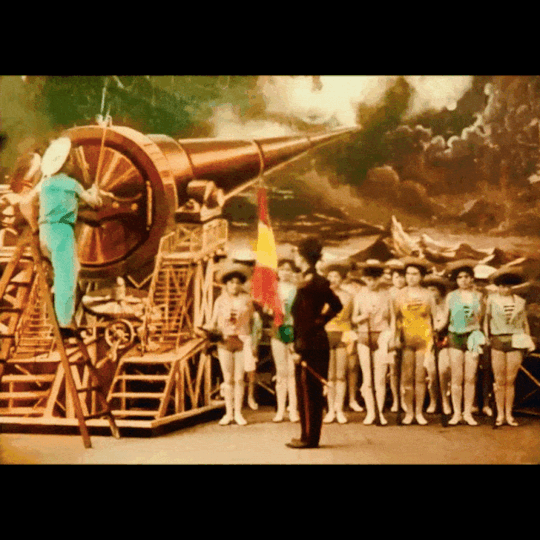
▲ El Meyers, “Le Voyage dans la lune” film excerpt, 1902. This “moon landing” themed film pioneered science fiction movies, which created a platform of imagination of fantasy and a tool for entertainment. Almost all the exhibitions commemorating Apollo would show This film in the West.
Another typical exhibition is the museum of the moon. The Moon Museum is an art installation project for global tours. British artist Luke Jerram replicates the moon at a ratio of 1:500,000. Through the images of NASA, he displays every corner and crack of The moon's surface on an internally illuminated 23-foot diameter sphere, representing 5 kilometers of the moon per centimeter. As Jerram said in an article, "I hope this project can reproduce a myth, inspire people's doubts and re-engage with the night sky " However, it is not as simple as a photo location. Its popularity comes from the result of the common emotions, myths and narratives of human beings. When you stand in front of this huge moon, it seems to be surrounded and impacted by The charm of the vast universe.
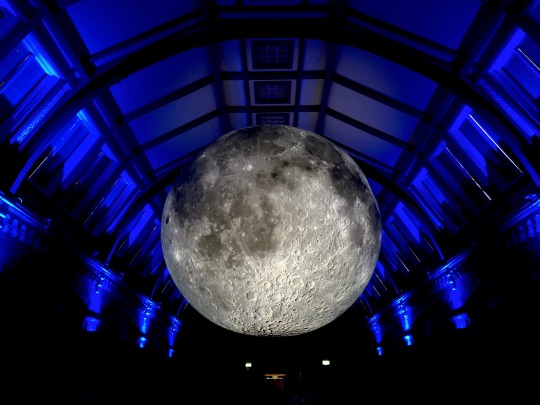
▲ Moon Museum, British National History Museum, London
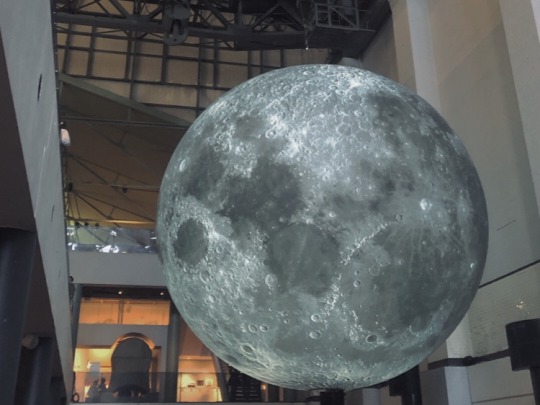
▲ Moon Museum, Powerhouse Museum, Sydney

▲ Moon Museum, Aga Khan Museum, Toronto

▲ Moon Museum, Milano
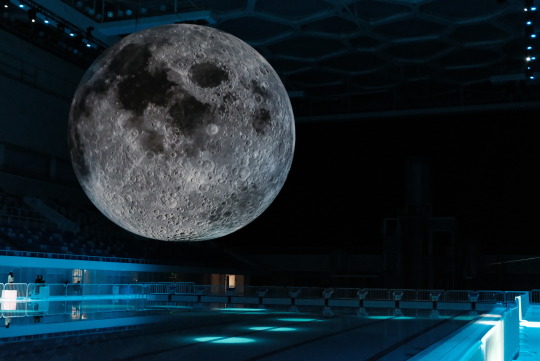
▲ Moon Museum, Water Cube, Beijing
As it travels from one place to another, it will collect new reactions, stories and myths, as well as musical compositions. The exhibition alway accompanies beautiful background music which was inspired from the moon image, moonlight and surround sound created by British composer Dan Jones Throughout history, the moon has inspired artists, poets, scientists, writers and musicians all over the world. The delicate new moon, the mysterious dark side of the moon, and its faint blue light, always evoke people's passion of exploration. The moon have allowed us to observe and think about cultural differences and similarities all over the world and to encourage human to explore deeper space science. (https:/ /my-moon.org/about/)
Back to the meaning of moon exhibition, those exhibitions aim to memorize the 50th anniversary of the first human landing on the moon. Under the competitive relationship of the first international landing, the scientific and technological strength of a country has become one of the important Criteria for measuring its political status. The father of aerospace, Orkovsky, proposed in the early 20th century that "the earth is the cradle of mankind, but human beings will not live in the cradle for ever, but will continue to strive to survive the world And space." Space is considered to be the fourth environment except the land, the ocean and the atmosphere. With the exploration, development and utilization of space by human beings, space has many meanings for the foothold and development of sovereign states. At any level, the activities, forms, and relationships of space politics are all about power, and the core of power related to space practice activities is Aerospace technology.
The beginning of the Apollo program is inextricably linked to political competition. In the fierce space competition between the United States and the Soviet Union in the late 1950s and early 1960s, the Soviet Union successively launched the world's first artificial earth satellite, the world's first moon Detecting, and the world's first manned spaceship. Which made The United States deeply feel that it is an extremely serious political issue. The United States has been eager to surpass the Soviet Union and determined to show its strength as the world's number one superpower On May 25, 1961, US President Kennedy announced to the world that he would implement the goal of sending people to the moon and returning them safely to Earth before the end Thus, the implementation of the manned mission to the moon in the United States is a political decision. The purpose is to re -establish theelectronic leadership of US in the world and to invigorate the spirit of the United States citizens.

▲ President Kennedy speaks on the “Apollo” project in Congress
Politically, it has finally established the United States in a leading position in many aspects of space technology, and has produced a great reputation. In science, it has made humans have the first direct research and understanding of the moon and near-moon space. In terms of technology, many breakthroughs have been made, which not only laid the foundation for the later aerospace program, but also widely used in the national economy.
At 10:26 am on January 3, 2019, the "Chang'e IV" detector successfully landed on the back of the moon and passed back a photo of the moon back through the relay star "Yuqiao", which is the first photo of The back of the moon in human history.

▲ The "Chang'e IV" probe was the first soft landing on the back of the moon in human history.
The geological features of the back and front of the moon are very different. Comprehensive exploration of the back of the moon can promote new understanding of the early evolutionary history of the moon and is of great value to the study of the early history of the Earth . Moreover, because the moon's rotation is the same as the revolution period, the back of the moon is never seen on the earth. Therefore, radio astronomical observations on the back of the moon can shield various radio interference signals from the Earth and monitor the electromagnetic signals that are indistinguishable from the ground and the Earth. It is a very significant astronomical achievement and be seen as an important step for China to become a superpower in space. This initiative immediately caused reports from major news media around the world.
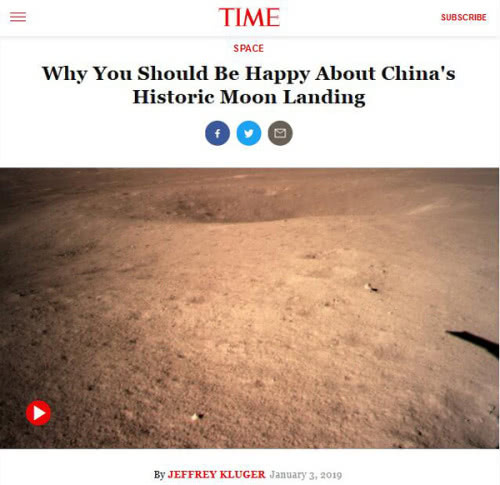
▲ The US “Times” website published a commentary on January 3 (https://time.com/5493033/china-lands-rover-moon-far-side/)
The US Time magazine website published on January 3rd, "Why should you be happy for China's moon landing achievements?", saying that the significance of China's fourth landing on the back of the moon cannot be estimated, even if China becomes a space power and world space. This is not only the success of China, but also the success of all mankind. China is making a force in space competition. Although it has been decades of space exploration, China is catching up quickly and may challenge the dominance of the United States in areas such as artificial intelligence and quantum computing.
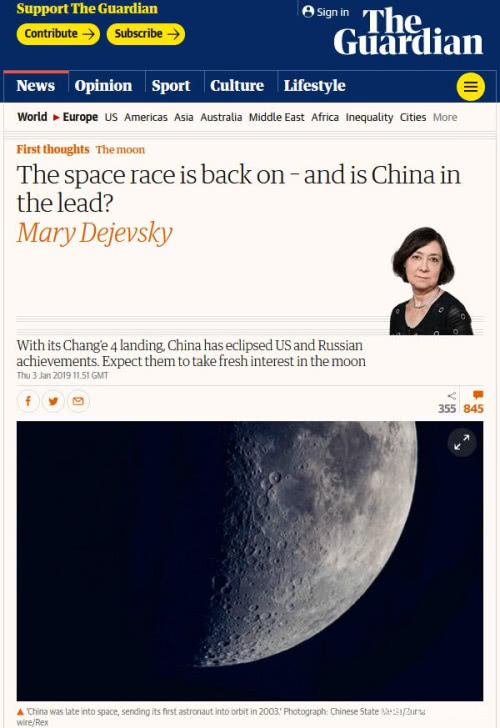
▲ British "Guardian" January 3 issue (https://www.theguardian.com/science/2019/jan/03/china-probe-change-4-land-far-side-moon-basin-crater)
The British "Guardian" published the "Space Race is back, is China leading?" on January 3, saying that the significance of the successful landing of the Chinese spacecraft on the back of the moon is not only because it is a human initiative, but also because it has enhanced China's The status of international space exploration has become a space power with the United States and Russia, and has also opened up a new dimension of competition. Today's China's success brings with it both excitement, challenges, and even threats . The Space Powers Club has a question mark on China's welcome. After the end of the Cold War, the United States and Russia began space cooperation, and the International Space Station was basically a shared platform. Such cooperation was basically not affected by political conflicts . It took the United States and Russia half a century to reach the current relationship of cooperation. The rise of China may break this tacit understanding. Will Russia regard China as a partner or an opponent? The anti-China attitude of the US Congress has been fully revealed. The United States not only regards China as an economic and military opponent, but also establishes a new space command in the US military to compete with China.

▲ "Nihon Keizai Shimbun" reported on January 3 that "China successfully landed the world for the first time on the back of the moon."
In a commentary published on December 29th entitled "China's Leading the World in the World", the newspaper pointed out that after the United States sent humans to the moon through the Apollo program, there were almost no plans for the detector to land on the moon . success. From the Soviet Union's "Lunar 24" landed in 1976 to China's "Chang'e 3" landed on the front of the moon in 2013, there was a 37-year gap between them. After entering the 21st century, only the Chinese detectors were landed on the moon. Following the Chang'e 4, it is advancing plans to launch the Chang'e 5 in 2019 and use the detector to bring back samples of rocks and other samples from the moon. Against the background of lunar exploration and development competition around the world, China has taken a step ahead and is likely to launch a new round of international space competition.
Through these reports, it is not difficult to see the importance and vigilance of space science and technology in various countries. Because the development of aerospace science and technology and the country's military strength, economic strength has a close relationship. "This is a small step taken by a person, but it is a big step for mankind."The famous saying of American astronaut Armstrong is the first sentence he said 50 years ago as the first person on the surface of the moon. That day was July 20, 1969. The "big step" he refers to is the achievements of mankind in the field of science and technology half a century ago. In fact, achievements are not only technological breakthroughs in aerospace capabilities, but also many inter-generational changes in human daily life. The Apollo program in the United States is costly, with about $25 billion in that year equivalent to nearly $200 billion today. This plan, while sending people to the moon, also triggered little-known technologic al advances in other fields.
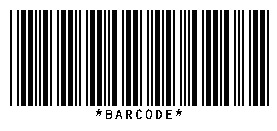
▲ Bar code for shopping pricing is one of the aerospace technology masterpieces that was originally invented by the United States to control the countless components of the Apollo program.

▲ The dried cabbage leaves in instant noodles are the dehydrated vegetables commonly used in aerospace foods. They are used to store, store, and transport excess water in vegetables. The Apollo program first uses this technology to allow astronauts to eat vegetables. Aerospace foods are now widely available in aerospace foods.

▲ All kinds of fashionable sneakers are also the “products” of Apollo's achievements. The “air blow molding” manufacturing technology is derived from the Apollo plan for the production of space suits. At that time, scientists made a complete and uniform thickness. The large-pressure space suit liner invented a method of heating and softening a group of pressure-resistant soft materials, placing them in a mold, and then blowing high-pressure gas into the mold. After that, the sneaker manufacturer found that the process could Quickly and efficiently create a complete upper that is widely used.
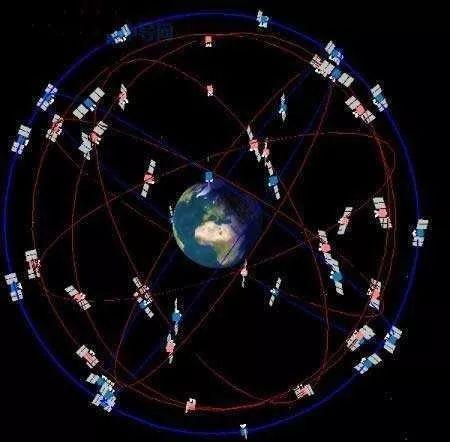
▲ GPS was the first generation of satellite positioning system jointly developed by the US Air, Sea, and Air Forces in the 1970s. The main purpose is to provide real-time, all-weather and global navigation services for the three major areas of land , sea and air. The initial research and development is a major alliance between aerospace satellites and military. Today, 24 satellites cover 98% of the world's regions. The network maps used on weekdays, enterprises accurately locate users to provide better services, etc. GPS is in us. Has become an indispensable member of daily life.

▲ The intensive care unit was one of the important medical advances brought by aerospace technology. It was originally born in response to the Apollo program’s need for health testing of astronauts on the moon.
Having said that, we will find that perhaps the moon is not an unreachable relationship with us. Aerospace technology is closely related to our country and has an inseparable relationship with our lives. Since then, the moon is no longer just a synonym for romance, but a mirror of technology. Mystery stems from the unknown. I believe that through the continuous exploration of mankind, we will be able to look beyond the depths of the universe and use our power to update our lives.
0 notes
Text
‘love you to the moon and back’
“I love you to the moon and back“, a quote from the children’s book "Guess How Much I Love You", meant to express that one loves another person more than they can imagine.

From ancient times to the present, MOON is always be seen as a symbol of beauty, romance and mysterious. Therefore, the curiosity and exploration to the moon have never stopped. On July 20, 1969, American astronauts Neil Armstrong and Buzz Aldrin became the first and second person to walk on the moon. At the time, US President Richard Nixon was in the first place. They talked to them on a landline. In the televised broadcast of the call, Nixon told the astronauts that the whole world is proud of them. "Because of everything you do, heaven has become a part of the human world." Humans regard the moon as a wonderful symbol. It is both the goal of scientific inquiry and political expansion, as well as the source of romance and the desire of art. Common ambitions and desires have gone through thousands of years of accumulation, and humans have finally had a close contact with the closest neighbors of the Earth half a century ago.
In order to commemorate the 50th anniversary of Apollo's moon landing and to explore the complex and strong attraction of the moon to humans, the global art circle has also presented exhibition projects related to the "moon" to explore the human image of the moon and its importance and power of charming.
Firstly, the exhibition of the Metropolitan Museum of Art in New York, Apollo's Muse: The Moon in the Age of Photography, explores the visual performance of the moon from the beginning of photography technology. In addition to the photos, the exhibition also features a series of related sketches, prints, oil paintings, movies, astronomical instruments and cameras used by Apollo astronauts.
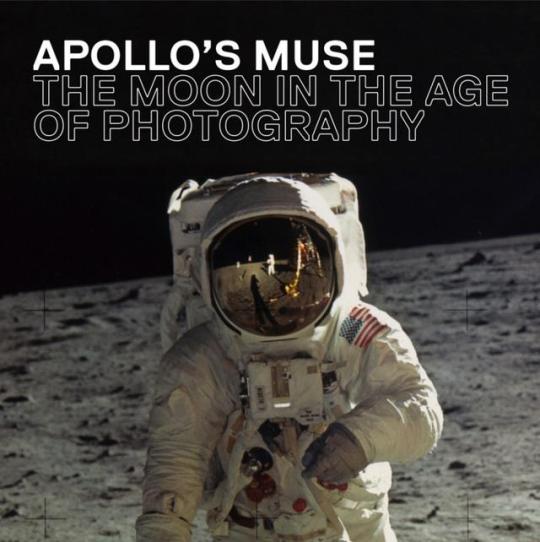
On July 20, 1969, 500 million viewers around the world watched the first moon landing photo uploaded by the American astronauts from the moon. The images helped humans remember this very historical moment in their unique way. The limit of human vision was pushed. To the new dimension.

▲ El Meyers, "Le Voyage dans la lune" film excerpt, 1902
This "moon landing"-themed film pioneered the sci-fi film, which made the film a platform for fantasy and a tool for entertainment. This year's exhibition in the West, which commemorated the 50th anniversary of Apollo's moon landing, almost all showed the film.
Another typical exhibition is the museum of the moon. The Moon Museum is an art installation project for global tours. British artist Luke Jerram replicates the moon at a ratio of 1:500,000. Through the image of NASA, he displays every corner and crack of the moon's surface on an internally illuminated 23-foot diameter sphere, representing 5 kilometers of the moon per centimeter. As Jerram said in an article: "I hope this project can reproduce a myth, inspire people's doubts and re-engage with the night sky." This installation of more than 30 museums, palaces and landmarks has been popular in Europe and the United States since two years ago. But it is not as simple as a photo location. Its popularity comes from the result of the common emotions, myths and narratives of human beings. When you stand in front of this huge moon, it seems to be surrounded and impacted by the charm of the vast universe.
https://www.youtube.com/watch?v=dX6HrVdtC7A
OLALA 2018-The Museum of the Moon, Luke Jerram
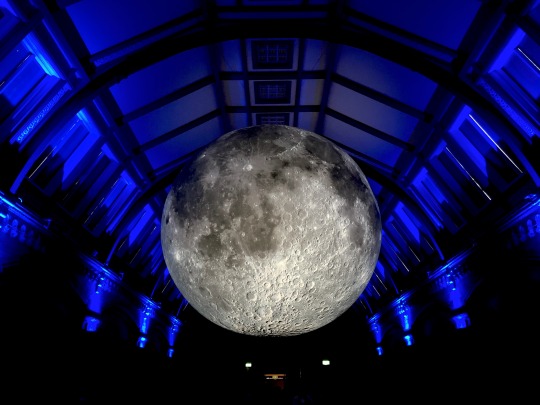
Moon Museum, British National History Museum, London
As it travels from one place to another, it will collect new musical compositions and continue to collect personal reactions, stories and myths, as well as highlight the latest lunar science. The device combines a moon image, moonlight and surround sound, created by British composer Dan Jones. From the beginning of human history, the moon has become a "cultural mirror" of our way of faith, understanding and observation. For centuries, the moon has been interpreted as a god and a planet. It is used for timing, calendaring, and assisted night navigation. Throughout history, the moon has inspired artists, poets, scientists, writers and musicians all over the world. A round of the moon, a delicate new moon with the sun, or the mysterious dark side of the moon, the faint blue light that evokes people's passion and exploration. Different cultures around the world have their own historical, cultural, scientific and religious relationships with the moon. The Moon Museum allows us to observe and think about cultural differences and similarities around the world and to consider the latest lunar science. The meaning and interpretation of the work will vary depending on where the work is presented. New stories and meanings will be collected through local research on the artwork of each location. (https://my-moon.org/about/)
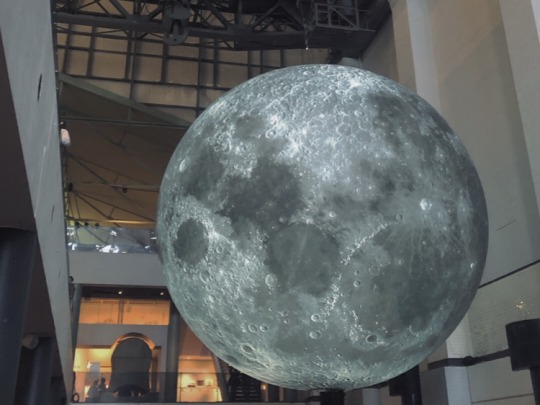
Moon Museum, Powerhouse Museum, Sydney

Moon Museum, Aga Khan Museum, Toronto

Moon Museum, Milano
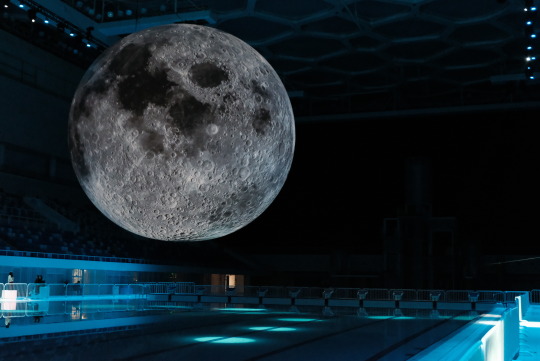
Moon Museum, Water Cube, Beijing
For a long time, human beings have a long-lasting fascination with the fascinating spheres in the sky, so this exhibition shows various paintings, scientific instruments and contemporary art through interactive installations, displays and art installations to explore the moon in human faith and science. And the various roles played in the arts.
Talking back to the meaning of moon exhibition, those exhibitions aim to memorize the 50th anniversary of the first human landing on the moon. In today’s context of the United States’ “returning to the moon”, the establishment of a lunar space station, and other countries competing to explore the moon, people cannot forget the political, scientific, technological, economic, and life-like aspects of Apollo’s manned moon landing on human society. Even the great influence and promotion brought by the spirit.For the time being, the US “Return to the Moon” program will also draw heavily on the experience and technology of the Apollo manned moon landing project. Many of the programs and technologies of the year are not out of date even today. The Apollo manned moon landing project will continue to affect the global influence for many generations and affect generations.

| Celebrate the 50th anniversary of the Apollo 11 moon landing logo. The prominent two letters O nested the Moon and Mars, respectively, meaning that the two planets NASA has explored, from "Apollo" to the moon, to "return to the moon", and then to Mars in the future. The next huge overflight refers to the next era to explore the focus: Mars. Samsung represents the three stars on the Orion belt. This logo was designed by NASA graphic artist Matthew Skins.|
In the fierce space competition between the United States and the Soviet Union in the late 1950s and early 1960s, the Soviet Union successively won several firsts: launching the world's first artificial earth satellite, launching the world's first moon detector, and launching it. The world’s first manned spaceship... The United States deeply feels that this is an extremely serious political issue. Therefore, the United States has been eager to surpass the slogan of the Soviet Union and is determined to show the United States as the world’s number one superpower. Level and national strength.
On May 25, 1961, US President Kennedy announced to the world that he would implement a majestic manned moon landing plan. “I think that our country should achieve the goal of sending people to the moon and returning them safely to Earth before the end of this decade.” Thus, the implementation of the manned mission to the moon in the United States is a political decision. The purpose is to re-establish the technological leadership of the United States in the eyes of the people of the world and to invigorate the spirit of the United States.

| President Kennedy speaks on the "Apollo" project in Congress |
The project is named after the sun god "Apollo". Although it can be seen as an ad hoc plan to compete with the Soviet Union, it is also the first step in human expansion into the solar system. Its purpose is to achieve manned moon landings and human field visits to the moon, for manned planets and Probing for technical preparation.
The Apollo manned moon landing project has greatly stimulated the slow-moving space program in the United States. Various people from all walks of life have offered suggestions, and it took only eight years to get on the moon.

| Apollo 11 Badge |
The success and achievements of the Apollo program have great historical and practical significance.
Politically, it has finally established the United States in a leading position in many aspects of space technology, and has produced a great reputation. In science, it has made humans have the first direct research and understanding of the moon and near-moon space. In terms of technology, many breakthroughs have been made, which not only laid the foundation for the later aerospace program, but also widely used in the national economy.
In engineering management, NASA has thus gained a series of valuable experience in large-scale engineering planning and management. Economically, this is a more controversial issue, but according to the Zeiss report, the “Apollo” plan has increased the US economic growth rate by 2%, the price index by 2%, and created 800,000 employment indicators. The Zeiss report also believes that In 1958, the US national income was 406.2 billion US dollars. In 1968, it reached 864 billion US dollars. In 1970, it increased to 90.46 billion US dollars.
The implementation of the project has led to a large number of high-tech industrial groups such as liquid fuel rockets, microwave radars, remote control operations, radio guidance, ultra-high strength and high temperature resistant synthetic materials, new electronic computers, pharmaceuticals and bioengineering. Later, many technical achievements such as artificial intelligence, robotics and remote control operations of the project were transferred to civilian use, which promoted the overall development and prosperity of science and technology and industry. The benefits of secondary development and application far exceeded the Apollo program itself. Direct economic and social benefits.
In the last 10 years of the 20th century, the United States was able to maintain high-speed and efficient growth, thanks in large part to the thousands of application technology achievements or patent applications in the economic field derived from the Apollo manned moon landing project. The United States is ahead of the world. High-tech, such as information, biology, and new materials, comes from the digestion, optimization, and secondary development of lunar exploration technology.
In the implementation of the Apollo manned moon landing project, in order to cool down and ensure the safety of the astronauts on the moon, the liquid cooling suit was developed. The principle is to use the pump to deliver cold water circulation refrigeration. Later, this technology was directly applied to the army, navy and air force. The working conditions of tankers, submarines and pilots have also reduced the suffering for some special patients. For example, there is a little boy who has scalded scalpel disease and can't dissipate heat through the skin. Therefore, most of his time can only be kept in the air-cooled environment. Many daily activities can't participate. After the liquid cold clothes, he can Go out and play, save from illness and loneliness.
Another popular bar code for shopping pricing is one of the aerospace technology masterpieces that was originally invented by the United States to control the countless components of the Apollo program.

The intensive care unit was one of the important medical advances brought by aerospace technology. It was originally born in response to the Apollo program's need for health testing of astronauts on the moon.

The dried cabbage leaves in instant noodles are the dehydrated vegetables commonly used in aerospace foods. They are used to store, store, and transport excess water in vegetables. The Apollo program first uses this technology to allow astronauts to eat vegetables. Aerospace foods are now widely available in aerospace foods.
All kinds of fashionable sneakers are also the "products" of Apollo's achievements. The "air blow molding" manufacturing technology is derived from the Apollo plan for the production of space suits. At that time, scientists made a complete and uniform thickness. The large-pressure space suit liner invented a method of heating and softening a group of pressure-resistant soft materials, placing them in a mold, and then blowing high-pressure gas into the mold. After that, the sneaker manufacturer found that the process could Quickly and efficiently create a complete upper that is widely used.

In conclusion, human desire for space and resources is growing towards rationality with the advancement of technology. On September 5, 1977, NASA unmanned probe traveler 1 launched into the solar system. Voyager 1 carries a gold-plated bronze record with a diameter of 30 cm, trying to introduce humanity to the extraterrestrial civilization as completely as possible. The album contains 115 pictures of the earth's features, humans, knowledge and solar system celestial bodies; 55 kinds of earth language greetings, beginning with the Aka German used by the Sumerians 6,000 years ago, ending in Chinese dialects; Dogs, birds, trains, and other "voices of the earth"; there are also music from a variety of cultures, including Beethoven's Fifth Symphony, Chinese Guqin "Water", Chuck Berry's rock, African blows Music, the voice of New Guineans, and so on. When astronomer Carl Sagan presided over the compilation of the album content, people's expectations of discovering extraterrestrial civilization seemed to be a little higher and more romantic than now, unlike the calmness of more than 40 years. Today, the urban legendary craze of UFO and alien signs is over, but serious exploration is still in progress.I don't know if we can see the breakthrough in our lifetime. We don't know when humans can really leave the cradle and start the interstellar voyage. We don't know whether the form of life will exceed the range we are familiar with, or even whether human cognition is enough to understand the universe and itself. The only thing that can be determined at the moment is that as long as the human species still exists, there will always be some members who will be the pioneers of travel, extending the footprints of human footprints and thinking to farther places.
1 note
·
View note